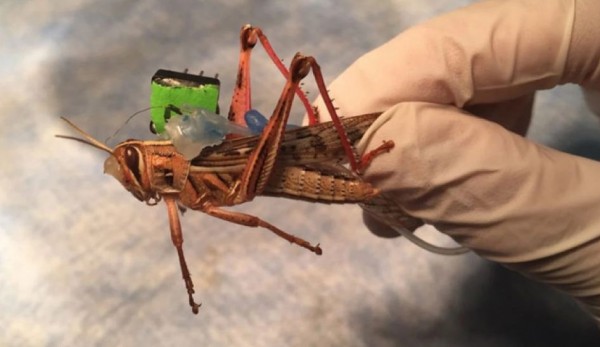US Navy Funding Research to Develop Bomb-Sniffing Locusts
| Arthur Dominic Villasanta | | Jul 07, 2016 09:30 PM EDT |
(Photo : Baranidharan Raman/Washington University in St. Louis) Bomb-sniffing locust
The U.S. Navy's Office of Naval Research (ONR) intends to develop bomb-sniffing locusts and has awarded Dr. Baranidharan Raman and his team at Washington University in St. Louis a $750,000 grant to make it happen.
Will bomb-sniffing locusts replace bomb-sniffing dogs? Who knows, but Dr. Raman is into sensor-based machine olfaction (the sense of smell) and bio-inspired intelligent systems. He studies how the brain processes complex sensory signals (especially olfactory cues), and to identify fundamental principles of neural computation. Dr. Raman has worked on locusts for years.
Like Us on Facebook
And why locusts and not, say, grasshoppers? Because locusts have sensitive olfactory systems thousands of times more complex than the best man-made chemical detection devices used today.
"Why reinvent the wheel? Why not take advantage of the biological solution?" asked Dr. Raman.
"That is the philosophy here. Even the state-of-the-art miniaturized chemical sensing devices have a handful of sensors. On the other hand, if you look at the insect antenna, where their chemical sensors are located, there are several hundreds of thousands of sensors and of a variety of types."
Dr. Raman explains it takes only a few hundred milliseconds for the locust's brain to begin tracking a novel odor introduced in its surroundings. Locusts process chemical cues very quickly. He said the first step in developing the Navy's bomb-sniffing locusts will be to harness locust antennae.
This will mean implanting sensors into the locusts' brains that can record and decode certain neural activity. The sensors will be connected to a small "backpack" containing a transmitter that will broadcast signals to a receiver linked to an LED.
If there are explosives, the LED will glow red. If there aren't any, the LED will turn green.
"We can do a surgery on (the locusts) and implant these electrodes into their brain," said Dr. Raman. "Within a few hours, they can recover and they can walk and behave as if nothing had happened."
The system that will guide these bomb-sniffing locusts will be developed by Professor Srikanth Singamaneni, also from Washington University. Dr. Singamaneniis developing what he calls "tattoos" that can steer the locusts by remote control.
Tagsbomb-sniffing locusts, Dr. Baranidharan Raman, U.S. Navy Office of Naval Research
©2015 Chinatopix All rights reserved. Do not reproduce without permission
EDITOR'S PICKS
-

Did the Trump administration just announce plans for a trade war with ‘hostile’ China and Russia?
-

US Senate passes Taiwan travel bill slammed by China
-

As Yan Sihong’s family grieves, here are other Chinese students who went missing abroad. Some have never been found
-

Beijing blasts Western critics who ‘smear China’ with the term sharp power
-

China Envoy Seeks to Defuse Tensions With U.S. as a Trade War Brews
-

Singapore's Deputy PM Provides Bitcoin Vote of Confidence Amid China's Blanket Bans
-

China warns investors over risks in overseas virtual currency trading
-

Chinese government most trustworthy: survey
-

Kashima Antlers On Course For Back-To-Back Titles
MOST POPULAR
LATEST NEWS
Zhou Yongkang: China's Former Security Chief Sentenced to Life in Prison

China's former Chief of the Ministry of Public Security, Zhou Yongkang, has been given a life sentence after he was found guilty of abusing his office, bribery and deliberately ... Full Article
TRENDING STORY

China Pork Prices Expected to Stabilize As The Supplies Recover

Elephone P9000 Smartphone is now on Sale on Amazon India

There's a Big Chance Cliffhangers Won't Still Be Resolved When Grey's Anatomy Season 13 Returns

Supreme Court Ruled on Samsung vs Apple Dispute for Patent Infringement

Microsoft Surface Pro 5 Rumors and Release Date: What is the Latest?













